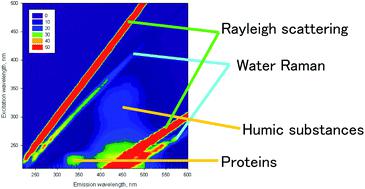当前位置:
X-MOL 学术
›
Environ. Sci.: Processes Impacts
›
论文详情
Our official English website, www.x-mol.net, welcomes your
feedback! (Note: you will need to create a separate account there.)
Fluorophores in surface freshwaters: importance, likely structures, and possible impacts of climate change
Environmental Science: Processes & Impacts ( IF 4.3 ) Pub Date : 2021-08-30 , DOI: 10.1039/d1em00273b Davide Vione 1 , Claudio Minero 1 , Luca Carena 1
Environmental Science: Processes & Impacts ( IF 4.3 ) Pub Date : 2021-08-30 , DOI: 10.1039/d1em00273b Davide Vione 1 , Claudio Minero 1 , Luca Carena 1
Affiliation

|
Fluorescence spectroscopy is one of the most useful techniques currently available for the characterisation of organic matter in natural water samples, because it combines easy availability of instrumentation, high sensitivity and limited requirements for sample treatment. The main fluorophores that can be found in natural waters are usually proteins (and/or free amino acids) and humic substances (humic and fulvic acids). The identification of these fluorescent compounds in water samples helps to obtain information about, among others, biological activity in the water body, possible transport of organic matter from soil, and the phenomenon of photobleaching that decreases both the absorbance and (usually) the fluorescence of natural organic matter. Interestingly, all these phenomena can be affected by climate change, which could alter to different extents the ratio between aquagenic and pedogenic fluorophores. Several events induced by warming in natural waters (and especially lake water) could enhance algal growth, thereby also enhancing the production of aquagenic organic matter. Intense precipitation events could increase the export of pedogenic material to surface waters, while photobleaching would be enhanced in the epilimnion of lakes when summer stratification becomes longer and more stable because of higher temperatures. Interestingly, photobleaching affects humic substances to a higher extent compared to protein-like material, thus protein fluorescence signals could be more preserved in stratified waters.
中文翻译:

地表淡水中的荧光团:重要性、可能的结构以及气候变化的可能影响
荧光光谱法是目前用于表征天然水样中有机物的最有用的技术之一,因为它结合了仪器的易用性、高灵敏度和对样品处理的有限要求。可在天然水中发现的主要荧光团通常是蛋白质(和/或游离氨基酸)和腐殖质(腐殖酸和富里酸)。水样中这些荧光化合物的鉴定有助于获得有关水体中生物活动、有机物质从土壤中的可能迁移以及光漂白现象降低吸光度和(通常)荧光的信息。天然有机物。有趣的是,所有这些现象都会受到气候变化的影响,这可以在不同程度上改变水生和成土荧光团之间的比例。由天然水域(尤其是湖水)变暖引起的一些事件可以促进藻类生长,从而也增加了水生有机物的产生。强降水事件可能会增加土壤物质向地表水的输出,而当夏季分层变得更长、更稳定时,由于温度升高,湖泊表层的光漂白会增强。有趣的是,与类蛋白质材料相比,光漂白对腐殖质的影响更大,因此蛋白质荧光信号可以在分层水域中得到更好的保留。由天然水域(尤其是湖水)变暖引起的一些事件可以促进藻类生长,从而也增加了水生有机物的产生。强降水事件可能会增加土壤物质向地表水的输出,而当夏季分层变得更长、更稳定时,由于温度升高,湖泊表层的光漂白会增强。有趣的是,与类蛋白质材料相比,光漂白对腐殖质的影响更大,因此蛋白质荧光信号可以在分层水域中得到更好的保留。由天然水域(尤其是湖水)变暖引起的一些事件可以促进藻类生长,从而也增加了水生有机物的产生。强降水事件可能会增加土壤物质向地表水的输出,而当夏季分层变得更长、更稳定时,由于温度升高,湖泊表层的光漂白会增强。有趣的是,与类蛋白质材料相比,光漂白对腐殖质的影响更大,因此蛋白质荧光信号可以在分层水域中得到更好的保留。而当夏季分层由于温度升高而变得更长和更稳定时,湖泊表层的光漂白会增强。有趣的是,与类蛋白质材料相比,光漂白对腐殖质的影响更大,因此蛋白质荧光信号可以在分层水域中得到更好的保留。而当夏季分层由于温度升高而变得更长和更稳定时,湖泊表层的光漂白会增强。有趣的是,与类蛋白质材料相比,光漂白对腐殖质的影响更大,因此蛋白质荧光信号可以在分层水域中得到更好的保留。
更新日期:2021-09-07
中文翻译:

地表淡水中的荧光团:重要性、可能的结构以及气候变化的可能影响
荧光光谱法是目前用于表征天然水样中有机物的最有用的技术之一,因为它结合了仪器的易用性、高灵敏度和对样品处理的有限要求。可在天然水中发现的主要荧光团通常是蛋白质(和/或游离氨基酸)和腐殖质(腐殖酸和富里酸)。水样中这些荧光化合物的鉴定有助于获得有关水体中生物活动、有机物质从土壤中的可能迁移以及光漂白现象降低吸光度和(通常)荧光的信息。天然有机物。有趣的是,所有这些现象都会受到气候变化的影响,这可以在不同程度上改变水生和成土荧光团之间的比例。由天然水域(尤其是湖水)变暖引起的一些事件可以促进藻类生长,从而也增加了水生有机物的产生。强降水事件可能会增加土壤物质向地表水的输出,而当夏季分层变得更长、更稳定时,由于温度升高,湖泊表层的光漂白会增强。有趣的是,与类蛋白质材料相比,光漂白对腐殖质的影响更大,因此蛋白质荧光信号可以在分层水域中得到更好的保留。由天然水域(尤其是湖水)变暖引起的一些事件可以促进藻类生长,从而也增加了水生有机物的产生。强降水事件可能会增加土壤物质向地表水的输出,而当夏季分层变得更长、更稳定时,由于温度升高,湖泊表层的光漂白会增强。有趣的是,与类蛋白质材料相比,光漂白对腐殖质的影响更大,因此蛋白质荧光信号可以在分层水域中得到更好的保留。由天然水域(尤其是湖水)变暖引起的一些事件可以促进藻类生长,从而也增加了水生有机物的产生。强降水事件可能会增加土壤物质向地表水的输出,而当夏季分层变得更长、更稳定时,由于温度升高,湖泊表层的光漂白会增强。有趣的是,与类蛋白质材料相比,光漂白对腐殖质的影响更大,因此蛋白质荧光信号可以在分层水域中得到更好的保留。而当夏季分层由于温度升高而变得更长和更稳定时,湖泊表层的光漂白会增强。有趣的是,与类蛋白质材料相比,光漂白对腐殖质的影响更大,因此蛋白质荧光信号可以在分层水域中得到更好的保留。而当夏季分层由于温度升高而变得更长和更稳定时,湖泊表层的光漂白会增强。有趣的是,与类蛋白质材料相比,光漂白对腐殖质的影响更大,因此蛋白质荧光信号可以在分层水域中得到更好的保留。











































 京公网安备 11010802027423号
京公网安备 11010802027423号